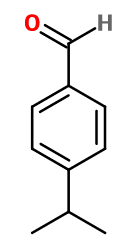
Photo credits: ScenTree SAS
Do you sell any of the raw materials? Would you like to let our users know?
Send an email to fournisseurs@scentree.coto learn about our advertising opportunities.
Do you sell any of the raw materials? Would you like to let our users know?
Send an email to fournisseurs@scentree.coto learn about our advertising opportunities.
General Presentation
-
CAS N° : 122-03-2
-
EINECS number : 204-516-9
-
FEMA number : 2341
-
FLAVIS number : 05.022
-
JECFA number : 868
-
Appearance : Colorless liquid
-
Density : 0,985
-
Volatility : Head
-
Price Range : €€€
Physico-chemical properties
-
Molecular formula : C10H12O
-
Molecular Weight : 148,2 g/mol
-
Log P : 2,98
-
Fusion Point : Donnée indisponible.
-
Boiling Point : 235°C
-
Detection Threshold : 34,1731 ng/l air
-
Optical rotation : Donnée indisponible
-
Vapor pressure : Donnée indisponible
-
Refractive Index @20°C : Donnée indisponible
-
Acid Value : Donnée indisponible.
-
Flash Point : 94°C
Uses
Uses in perfumery :
Cuminaldehyde is used in leather, spicy notes, in heavy and spicy flower accords (e. g. carnation), in oriental and woody accords and for sweaty notes. Used as a replacor for Cumin EO, in which it is found at about 30% of the composition.
Year of discovery :
Data not available.
Natural availability :
Cuminaldehyde can be extracted in its natural state from Cumin EO, as it represents 40% of its composition.
Isomerism :
The ortho and meta isomers isolated from Cuminaldehyde are not used in fine perfumery. Cuminaldehyde is a constitutional isomer of Anethole, which has a very different smell reminiscent of Star Anise EO.
Synthesis precursor :
Cuminaldehyde is the precursor to several raw materials. Its oxidation gives Cuminic Acid, the hydrogenation of the aldehyde function leads to Cuminic Alcohol and its total hydrogenation synthesizes Mayol with a smell of lily of the valley. It can also form a Schiff base with Methyl Anthranilate, with a fruity and more artificial smell, or a dimethyl acetal which also has an olfactory interest.
Synthesis route :
Cuminaldehyde synthesis is made by reduction of 4-Isopropylbenzoyl chloride or by formylation of cumene.
Regulations & IFRA
Allergens :
This ingredient does not contain any allergen.
IFRA 51th :
This ingredient is restricted by the 51th amendment
- Quantitative limit on the use :
-
Cat.1 Cat.2 Cat.3 Cat.4 Cat.5A B C DCat.6 0,085 % 0,025 % 0,51 % 0,47 % 0,12 % 0,12 % 0,12 % 0,12 %0,28 % Cat.5A B C DCat.6 0,12 % 0,12 % 0,12 % 0,12 %0,28 % Cat.7A BCat.8 Cat.9 Cat.10A BCat.11A BCat.12 0,96 % 0,96 %0,05 % 0,92 % 3,3 % 3,3 %1,8 % 1,8 %No Restriction Cat.10A BCat.11A BCat.12 3,3 % 3,3 %1,8 % 1,8 %No Restriction
Annexe I :
Some regulated synthetic ingredients are found in nature and in certain proportions in natural ingredients. This presence in nature has to be taken into account when calculating limits of use recommended by the IFRA. In case you do not know these concentrations, you can use the ones estimated by the IFRA. Here they are :
| List of regulated compounds contained in this ingredient | |||
|---|---|---|---|
| Ingredient Name | Botanical Name | CAS N° | Estimated Concentration |
| Cubeb oil | Piper cubeba L. f. | 8007-87-2 | 0,09 |
| Cumin seed oil | Cuminum cyminum L. | 8014-13-9 | 21 |
| Lavender absolute | Lavandula angustifolia angustifolia | 8000-28-0 | 0,06 |
| Perilla oil | Perilla frutescens (L.) Britton | 68132-21-8 | 0,24 |
| Lavender oil dentata | Lavandula dentata | 93165-50-5 | 0,2 |



